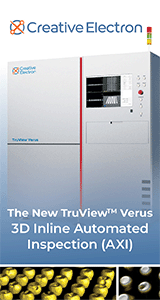Authored By:
Harald Wack, Ph.D., Umut Tosun, M.S.Chem. Eng., Ravi Parthasarathy, M.S.Chem.Eng, Jigar Patel, M.S.Chem. Eng.
ZESTRON America, Manassas, VA USA
Transcript
While most cleaning processes in the global electronics manufacturing industry still rely on cleaning with DI-water only for OA flux removal, recent studies suggest that water is beginning to reach its cleaning limitation, favoring the use of chemically assisted cleaning processes.
The increased use of water-soluble lead-free solder requires more activators and higher soldering temperatures, which result in more burnt-in fluxes and produce water insoluble contamination. DI-water alone has a limited to no ability to solubilize non-ionic residues on the board's surface.
These findings coincide with the use of smaller, more densely packed components which further limit the effectiveness of pure DI-water. Due to its high surface tension, water cannot effectively penetrate underneath low standoff components. Chemistry assisted cleaning processes, however, can reduce the surface tension and therefore eliminate penetration problems.
This technical case study complements the authors' initial in-house findings by comparing them to actual production assemblies and conditions. The engineering team at a participating customer site designed this comprehensive blind study to determine removability with DI-water versus various chemistry supported systems.
The findings revealed significant experimental data, which shed much needed light on this emerging industry challenge.
Initially Published in the IPC Proceedings
|




